History
Description to the photo: Hannover CL-II No. 8.2 aircraft renovated at the Central Aviation Workshop at Pole Mokotowskie. Visible military hangars. The plane has a Mercedes Benz engine with 147 kW (200 HP).
Hannover CL-II in Poland.
Among the aviation equipment captured from the former invaders in 1918-1919, there were also Hannover CL-II combat aircraft. Poland acquired 10 Hannover CL-II aircraft and 13 Hannover CL-IIa aircraft. One Hannover CL-IIIa No.218 / 18 was officially purchased. According to the first census of February 1919, there were 15 Hannover CL-II aircraft in Kongresówka and Małopolska. Several planes were seized in Greater Poland. According to the September 1919 census, the Polish Army used 17 Hannover CL-II (Hannoversche Waggonfabrik A.G.) and Hannover CL-IIa (Luft-Fahrzeug-Gesellschaft – LFG Roland) aircraft. The Hannover CL-II planes, after repairs at the Central Aviation Workshop, received the Polish type number 8 and were in the years 1919–1920 with intelligence squadrons. Hannover CL-II planes took part in the Polish-Bolshevik war. In January 1921, the surviving Hannover CL-II aircraft were withdrawn from airline service.
In November 1919, the Central Aviation Workshop was established. The Polish Army, however, had few operational planes. The management of the Central Aviation Workshop took action to launch serial production of new aircraft, which would be the basic combat aircraft. The design of the Hannover CL-II was judged to be the most suitable. The team of designers was headed by Lieutenant Engineer Karol Słowik. Engineer Zdzisław Wilk became his Zasępca. Measurements of the existing airframes were made and workshop drawings were made. Then, drawings for serial production were made, adapting the plane to the resources and workshop tools at hand. The aircraft differed from the prototypes in many solutions.
The main difference was the engine used. The first aircraft used an Austro Daimler engine with 118 kW (160 hp), which was weaker than the original Argus As.III, with 134 kW (180 hp). But the Austro Daimler engine had less weight. Austro Daimler engines were known in Poland because they were used in Austro-Hungarian planes, for example Brandeburg C-I and Lloyd C-II. For the Austro Daimler engine at the Central Aviation Workshop, a new engine mount and engine guard were developed. Thus, the entire front of the aircraft was developed at CWL (CAW).
Polish Army Aviation has ordered 10 Hannover CL-II "Słowik" planes in three series. The first series consisted of three planes which were given numbers: 18.1, 18.2, 18.3. Central Aviation Workshops were well prepared for serial production. They had a lot of raw materials that were left over from the Refla factory (Refla Militarerkstatten Albatros), which operated in Warsaw during the Great World War. The factory built the Albatros B-II planes serially.
The Hannover CL-II "Słowik" plane was built relatively quickly. However, due to the lack of appropriate instruments, not many strength tests were performed, apart from the strength tests of pine wood. The tangential loading of the entire structure has not been tested.
The first flight of the Hannover CL-II "Słowik" was made on August 9, 1919. The pilot was Bolesław Skraba. The plane was correct in flight, but the pilot noticed weak stiffening of the wings. As a result, the wings twisted in flight and twitched abnormally. The pilot assessed that the flights on this plane are risky. But the tests were not interrupted and even sharper turns were tried. On August 23, 1919, Pole Mokotowskie was visited by the Head of State, Józef Piłsudski. The Hannover CL-II "Nightingale" airplane was shown on the ground and in flight. The crew of the plane was Lieutenant Engineer Karol Słowik and Second Lieutenant Pilot Kazimierz Jesionowski. During the descent flight, the plane disintegrated in the air and crashed to the ground 150 meters from the public. The crew died on the spot. The generals left the airport in silence. Józef Piłsudski also left without a word.
A study was conducted by engineers Arndt, Cywiński and Pęczalski. The Hannover CL-II "Słowik" No. 18.2 aircraft was subjected to load tests using sandbags. With an incomplete load, about 50%, the upper wing node (fitting) did not withstand and was damaged as much as Hannover CL-II "Słowik" No. 18.1. The study also showed that the rear upper wing spar was too weak. The stiffening lines used were not suitable for this purpose. The lines stretched and did not return to their length. The construction of the next Hannover CL-II "Słowik" aircraft was abandoned.
In January 1920, Major Pilot Engineer Zdzisław Zych-Płodowski became the head of the Central Aviation Workshop. The new manager proposed to modernize the Hannover CL-II aircraft used in Poland. The modernization consisted in the replacement of worn, unreliable and weak Argus Opel engines, 132 kW (180 HP), with Mercedes Benz engines, 147 kW (200 HP), which were in stock in Polish warehouses. The engines were replaced during repairs of Hannover CL-II aircraft. The new engines fitted into the stock after minor changes. The fuel installation needed to be changed. The engine housing (bonnet) remained unchanged. The Mercedes Benz engine was slightly taller and the exhaust pipe protruded high above the canopy, so visibility from the plane was more limited.
The new aircraft was designated the Hannover CL-IIE and was liked more by pilots than the Hannover CL-II and Hannover CL-IIa. It is not known exactly how many Hannover CL-IIE aircraft were modified. It is estimated that there were no less than three planes. Already at the beginning of 1921, Hannover CL-II planes were withdrawn from service in the Polish Army.
Written by Karol Placha Hetman

